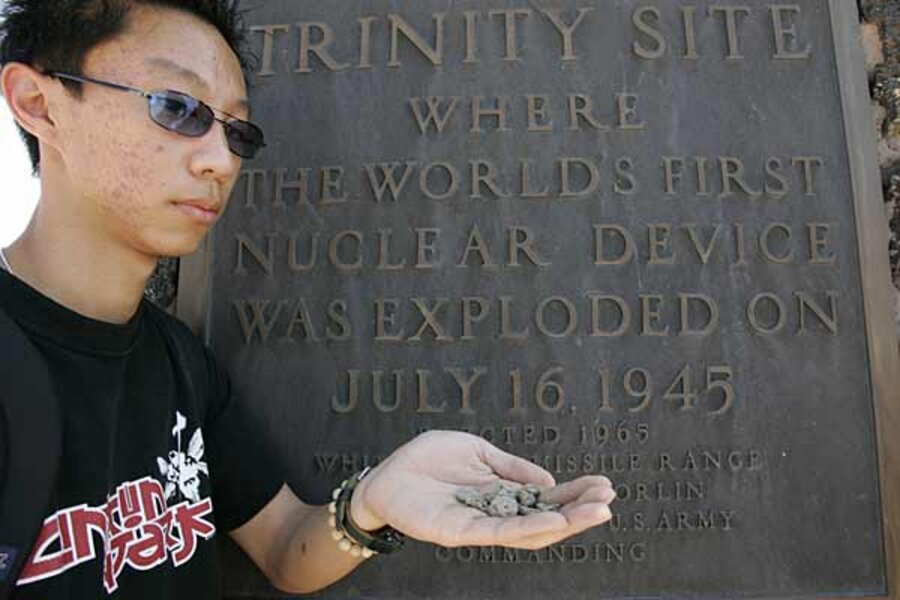Scientists use 'trinitite' from 1945 to help decode nuclear blasts
It's called trinitite: a glassy byproduct of the searing heat that cooked the desert at the White Sands Proving Ground in 1945 when the United States conducted its first atomic-bomb test.
Now, researchers have taken a fresh look at this detritus and found that they can glean the kind of information that could be valuable in figuring out how a detonated nuclear device was built and perhaps where key ingredients came from.
Such a capability has long been a focus of efforts to improve scientists' ability to trace the origin of a device used in a terrorist nuclear attack. But much of the work done so far has been by US weapons scientists who have been reluctant to speak in much detail about how well their tools work.
Now, a team of scientists at the National Institute of Standards and Technology (NIST) has demonstrated an ability to analyze post-blast debris for potentially valuable evidence, and has openly published the results.
The work represents "a signpost that says: Look, this is what we can possibly get" out of debris samples, says Albert Fahey, a physicist at NIST's lab in Gaithersburg, Md.
The next step is to analyze a wider variety of post-blast debris, "then we can decide what we really need to know" to make the most out of the analytical approach the team used, he says.
Nuclear-weapons scientists have analyzed post-explosion debris for decades, but usually with an eye toward evaluating the effectiveness of the weapons they've built, or in the case of above-ground tests by another country, to determine what the explosive yield was, Dr. Fahey says. Such has been the case with trinitite.
But in speaking with weapons scientists, he says he learned that "they never bothered to ask the question: If I didn't know what happened, how could I figure it out?" he says.
Fahey, whose background is in teasing from meteorites chemical clues to their origins, adds that the question is one cosmochemists try to answer all the time.
He and his team opted to apply the question to trinitite to see what it could tell them about the "gadget," the plutonium bomb Manhattan Project scientists perched on a 100-foot tower and detonated on July 16, 1945. With one exception, he says, the tools for analyzing the sample are available in any reasonably well-appointed geochemistry lab.
The team took a thin slice of the button-shaped trinitite sample bought from a mineral collector, polished it, and then analyzed it under an electron microscope, which can reveal tiny details within the sample. Rather than finding the uniformly mixed blob of fused New Mexico soil that many suspected, the team found layers and swirls that suggests turbulence within the molten material before it cooled. And they uncovered clear differences in the composition of the slice from one location to another across the sample.
The team then measured x-rays coming off the still slightly radioactive material, building a kind of map they could use to compare against the locations of different compounds in the sample. Finally the scientists used two types of spectrometers to identify the different compounds and their variations, or isotopes, which allowed them to distinguish between material from the bomb and natural material that may have been swept up from the landscape as the fireball rose.
After analyzing the results, they were able to distinguish between naturally occurring uranium and the enriched uranium used in what weapons designers call a bomb's "tamper" – in this case a layer of uranium surrounding the "gadget's" plutonium core to improve the bomb's explosive efficiency.
The results represent "a big step forward," says Kim Knight, a geochemist working in the field of nuclear forensics at the Lawrence-Livermore National Laboratory in Livermore, Calif.
She notes that a great deal of emphasis has been placed on tools needed to analyze nuclear material intercepted before it can do any harm. Fahey's team's work highlights "a renewed interest in looking at relationships which may be preserved" in post-detonation debris "that we just weren't as interested in previously."
In addition, by unveiling the results in a publicly available scientific journal, in this case the Proceedings of the National Academy of Sciences, the work gives policymakers and budgeteers some sense that scientists are making progress in devising the techniques that will identify the design and sources of nuclear devices terrorists might use, she says.
The challenge, experts say, is developing the tools to analyze nuclear evidence with a high degree of confidence in the results and in a timely manner to allow policymakers to marshal a speedy response against the right perpetrators in the event of an attack.





